Introduction to types of presentations
Different types of presentations pave your way to changing decisions, conveying important messages, and influencing the audience through various settings. Presentations help you clearly convey ideas in a public seminar, classroom, or business boardroom. Not all presentations have the same purpose.
Audience engagement and understanding will be greatly influenced by the type of presentation you choose. They come in different types, such as persuasive, informative, informational, pitch decks, progress reports, and decision-making. All these types allow you to choose the most impactful approach to meet your specific goals.
“A well-structured presentation is not just about delivering content; it’s about creating an experience for the audience.”
If you need insights and information about presentation types, this guide is for you. Whether you are a business expert, a university student, or a member of an inspiring team, bear in mind that the right kind of presentation will bring you success. this tutorial looks at many kinds of presentations, their salient features, recommended practices, and ideal use cases to let you create interesting and powerful presentations.
Table 1: Introduction to Different types of presentations
| Presentation Type | Purpose | Target Audience |
| Persuasive | Influence decisions and change opinions | Business professionals, marketers, sales teams |
| Informative | Educate and share knowledge | Teachers, trainers, students |
| Informational | Present key facts and updates | Corporate teams, general audience |
| Pitch Decks | Attract investors and stakeholders | Startups, entrepreneurs, business owners |
| Progress Reports | Update on ongoing projects and performance | Project managers, teams, executives |
| Decision-Making | Provide data and analysis for key choices | Executives, board members, strategic planners |
| Educational/Informative | Deliver in-depth knowledge on a specific subject | Students, academic professionals, lifelong learners |
| Demonstration or How-To | Show step-by-step processes or instructions | Customers, trainees, hobbyists |
| Persuasive | Motivate to take action or support a cause | Marketing teams, advocacy groups, sales personnel |
| Motivational/Inspirational | Inspire and motivate towards goals or personal growth | Employees, teams, general audiences |
| Storytelling | Engage through narratives and emotional connections | General audience, creative teams, marketing |
| Decision-Making | Provide data and insights to facilitate informed decisions | Business analysts, managers, strategic leaders |
| Status or Progress Report | Communicate accomplishments and ongoing tasks | Internal teams, stakeholders, upper management |
| Visual-Heavy | Use visuals to enhance message and engagement | Visual learners, creative teams, event planners |
| Interactive | Engage participants through interactive elements | Workshop attendees, educators, event moderators |
Continue reading this article to get any information you need in this regard. We at Do My PowerPoint are also ready to help you with your presentation matters. Stay with us till the end.
This tutorial looks at many kinds of presentations, their salient features, recommended practices, and ideal use cases to let you create interesting and powerful presentations. We mention types of presentation styles in another article.
In the Upskillist Youtube channel, we have:
There are various reasons as to why you might give a presentation.
Take a look at this useful overview of the most common types of presentations and their relevant outcomes so that you can choose the correct type of presentation for the specific application.
Types of presentations:
Motivational presentations: the purpose of this type is to inspire or motivate like a TED talk.
Persuasive presentations: this type is used to try to persuade others to take their standpoint on something. An example would be a sales pitch.Informative presentations: used to inform. For example, a lecturer presenting to a class or a company’s year-end sales results.
Instructive presentations: the presenter explains how to go about doing something. Some examples include workshops, training sessions and webinars.
Decision-making presentations: a presentation that shares a problem, solution options, and their outcomes. An example would be a business meeting.
Progress presentations: bring the audience up to date with the progress of certain projects. An example would be a quarterly sales performance.
If you’re looking for a unique presentation format, consider using a Pecha Kucha style presentation, which is a concise and visually engaging way to present ideas effectively.
According to the goal of your presentation, the kind of presentation is essentially the process of creating presentation slides, which aids in the selection of information that is appropriate for the meeting’s purpose. To help you choose the best course of action for creating PowerPoint content and design (powerpoint design services), we will explain the various presentation kinds in this post.
To create impactful presentations, you can leverage professional presentation design services to ensure your slides align with your goals. If you’re considering budgeting for a presentation, you may want to review a PowerPoint presentation price list to get an idea of the costs involved.
Educational/ Informative presentation

The Educational/Informative presentation is the first type of presentation discussed in this article, highlighting its role among the different types of presentations.
Check out our comprehensive guide and discover everything you need to know about creating an impactful Informative Presentations.
Educational/Informative presentation could be a sort of introduction that points to communicate information or data to the gathering of people. These sorts of presentation are regularly made to upgrade, teach, or offer precise and pertinent data to the gathering of people.
Presentation can be conducted over diverse areas like logical, specialized, restorative, commercial, social, and social. academic, corporate, and professional environments where knowledge-sharing and data are vital often find use for these presentations.
Educational/ Informative presentation in various projects such as:
- scientific
- technical
- medical
- commercial
- social
- cultural
In the Comm Studies channel we have:
This video provides an example of a college student presenting an informative speech. Throughout the video there are subtitles to point out different components of the speech process.
Here is a file for an informative speech outline example. Speech Outline Example I
In this fashion of introduction, information is organized in an organized and consistent way for simple comprehension and maintenance by the gathering of people. the essential objective of such introductions is to teach the gathering of people, giving them with modern data and extending their understanding of a specific subject.
Key Characteristics and Best Practices
- Goal and fact-based: Steers clear of views and persuasion.
- Clear introduction, body, and conclusion make up the structured approach.
- Often including graphs, charts, and statistics, data-driven is
- Focusses on conveying pertinent information without needless details, therefore being succinct and accurate.
“Simply and clearly is the secret to a superb instructive presentation. The communication is more successful the more straightforward and ordered the material is.
Examples of Scenarios
- Corporate reporting and updates
- Results of research in scholarly environments
- Industry patterns and market study
Visual Example/Template
- Bullet points on slides.
- charts and graphs to graphically depict statistics
- simple comprehension infographics
Demonstration or how-to presentation
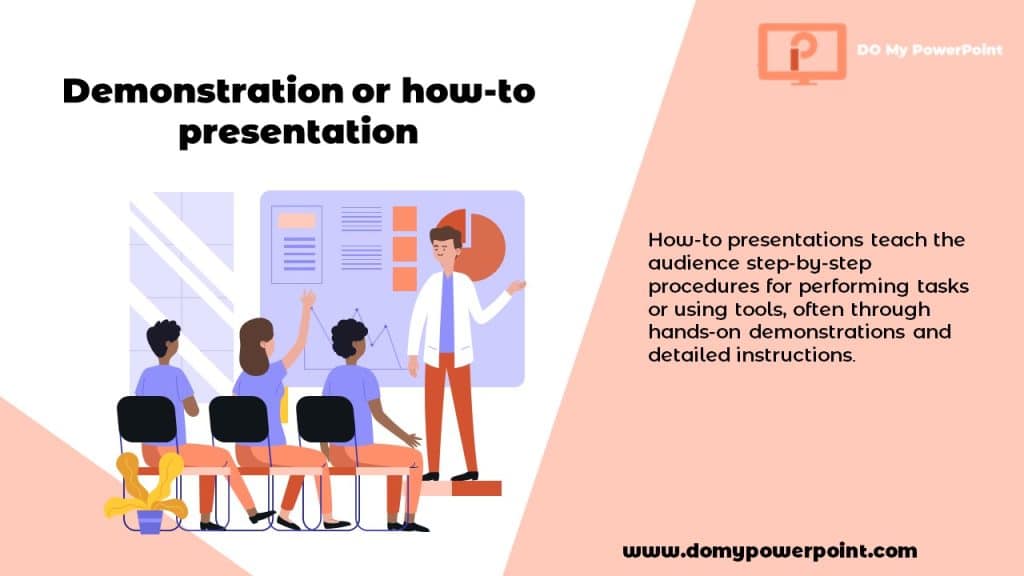
The Demonstration or How-To presentation is one of the most practical forms among the different types of presentations, offering step-by-step guidance on a specific topic.
Demonstration or How-To Presentation could be a sort of Presentations that looks for to taught the gathering of people on how to perform an assignment or utilize a specific apparatus or item. These sorts of Presentations show the gathering of people with a hands-on approach, directing them through different steps and stages of a movement.
Instructional presentations are meant to provide the audience with the knowledge to carry out a certain chore or operation. These presentations are very useful and interesting as they divide difficult chores into simple, easily followed procedures.
Shows or instructive shows are regularly presented visually with real apparatuses and hardware to supply the group of onlookers with a hands-on understanding of the subject.
Amid an occasion or instructive session, the moderator ordinarily educates the watchers how to total an assignment proficiently and effectively by giving nitty gritty clarifications and showings for each organize of the method. Different settings, such as classrooms, workshops, conferences, instructive recordings, and tv programs, can utilize these sorts of Presentations.
Presentation and instructive introductions can be seen in cooking instructional exercises, specialized workshops, on-the-job preparing sessions, and online video instructional exercises.
An outline of cooking may include appearing each step of planning, cooking, and serving a feast. In a specialized workshop, enlightening on employing a specific gadget or carrying out a particular repair may be illustrated in a hands-on, orderly way.
Regularly, exhibiting or instructing occasions emphasizing hands-on and real-world learning help in gathering of people acquiring new skills and information proficiently. Such Presentations improve gathering of people learning by outlining each step of a prepare in detail, making it more locks in and justifiable.
Key Characteristics and Best Practices
- Step-by-step instructions: follows a disciplined, sequential pattern.
- Often including recorded lessons or live demonstrations, hands-on activities
- Encouragement of questions and real-time involvement by the audience
“A great instructional presentation shows and involves not just tells.”
Examples of Scenarios
- Sessions of employee development
- Software walkthroughs and tutorials for products.
- cooking and do-it-yourself seminars
Visual Example/Template
- Checklists and number lists
- Images and process diagrams in screenshots
- Included instructional films on embedded platforms.
Persuasive presentation
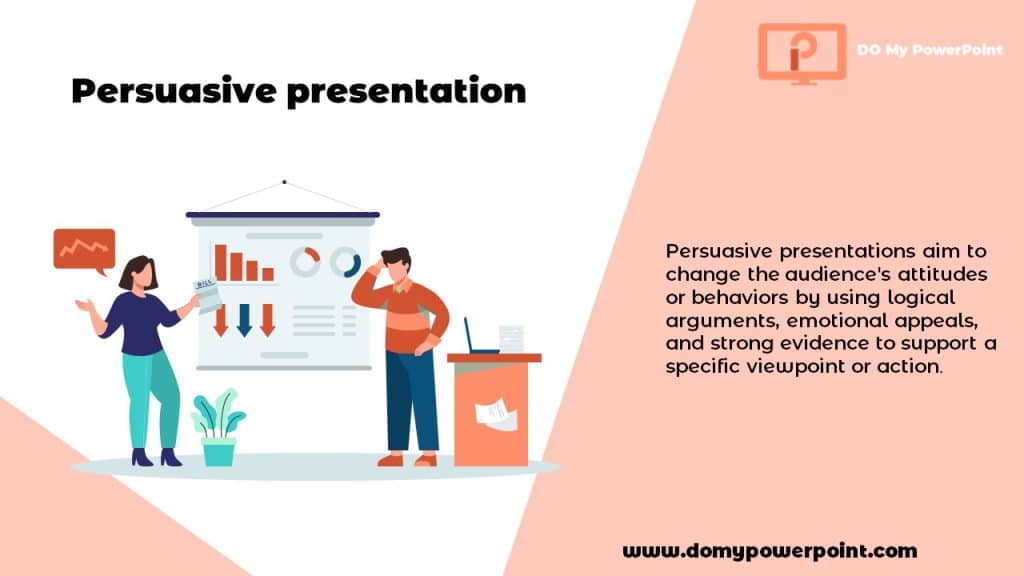
The Persuasive presentation stands out among the different types of presentations for its focus on influencing opinions and driving action.
A strong presentation seeks to change the opinions, attitudes, or behavior of the audience. a persuasive presentation is another one of the different types of presentations may be a sort of presentation that points to induce the group of onlookers to acknowledge a specific point of see, conviction, or activity.
These sorts of presentations endeavor to alter the audience’s states of mind, convictions, or behavior by utilizing coherent contentions, narrative prove, and passionate offers. Also it is move the audience toward a certain choice by use of emotional appeals, logical reasoning, and gripping narrative.
Persuasive Presentation are commonly utilized in different areas such as:
- Trade
- Legislative issues
- Law
- Promoting
- Social issues
The video below is a good example of a persuasive presentation.
In persuasive presentations, the speaker must carefully get it wants and concerns of the gathering of people and adjust his/her substance in such a way that the group of onlookers feels that the subject beneath discourse is imperative to them.
Utilizing solid prove, measurements, definitive cites, and viable illustrations can offer assistance make this sort of introduction more compelling. In expansion, making a passionate association with the group of onlookers and utilizing individual stories or genuine illustrations can advance impact the group of onlookers.
Illustrations of influential introductions incorporate political discourses, commercials, social campaigns, and deals introduction.
For case, a political discourse may be pointed at convincing individuals to back a specific candidate or approach. In a deals presentation, the objective may be to persuade clients to purchase an item or benefit. Or, in a social campaign, the supplier may attempt to induce the audience to alter their behavior in arrange to secure the environment.
In common, enticing presentations endeavor to convince gatherings of people to acknowledge or act toward a specific objective by employing a combination of consistent contentions and passionate offers. These sorts of introductions play a critical part in changing the demeanors and behaviors of people and bunches.
Key Characteristics and Best Practices
- Strong opening: draws in readers with a question, statistic, or quotation.
- Logical argumentation creates evidence-based case study by use of reason.
- Emotional connection: Employ strong images, anecdotes, or testimonies.
- Encouragement of the audience to go on is clear call to action.
“The most effective persuasive presentations inspire action not only present facts.”
Examples of Scenarios
- Sales presentations and marketing initiatives
- Political and activist talks
- Appeals to donations and funding
Visual Example/Template
- Excellent pictures and powerful imagery
- Testimonials and firsthand knowledge
- Before-and-after contrasts
If you’re considering professional assistance in crafting persuasive PowerPoint slides, check out the cost of PowerPoint presentation to plan your expenses accordingly.
Motivational or inspirational presentation
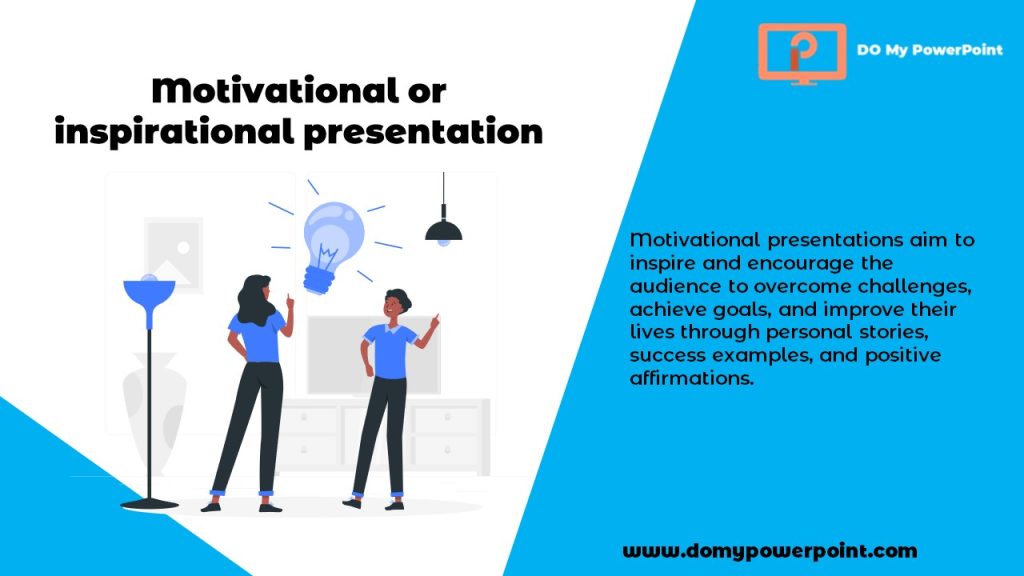
Among the different types of presentations, the Motivational or Inspirational presentation aims to uplift, energize, and inspire its audience to take action.
Motivational or Inspirational Presentation points to rouse and persuade the group of onlookers to realize objectives, overcome challenges, and improve their individual or proficient life.
Regularly, people who have finished accomplishments or have propelling stories convey these presentations to motivate others to seek after victory and take activity.
Amid motivational or rousing discourses, the moderator frequently offers individual accounts, fruitful illustrations, elevating cites, and positive assertions to persuade the swarm to have self-confidence, build up destinations, and work towards finishing them.
This presentation type helps people who have problems that they cannot cope with or need motivation to lead them to success.
Motivational or Inspirational Presentations can often be found in TED talks, personal coaching sessions, personal development workshops, and conference keynotes, so if you’re looking for this type of presentation, it’s important to get the tips right. Prepare.
An occurrence might be when a motivational speaker relates his individual travel, specifying the deterrents he has prevailed and the triumphs he has earned, in arrange to motivate the gathering of people almost the plausibility of coming to objectives through devotion and tirelessness.
Finally, a motivational or inspirational presentation seeks to inspire motivation and enthusiasm to achieve goals in its audience.
Now, as the population expands and the markets become more competitive, there are many motivational speakers working with a diverse range of methods, goals, topics and techniques. Therefore, it is necessary that the type of presentation that you prepare for your presentation is suitable for this presentation model.
Key Characteristics and Best Practices
- Emotionally interesting; use personal tales, real-life instances, or narrative devices.
- Strong Call to Action: Motivational the audience to participate in significant activity.
- Positive and uplifting tone: emphasise hope and conquering of obstacles.
- Strong Visuals: Employ striking graphics, movies, and less text.
- Interactive Components: Challenge the viewers with provocative questions or tasks.
Examples of Scenarios
- Keynote address at a leadership conference;
- Motivating speech for staff about welcoming change;
- A TED-style discussion on conquering hardship.
Visual Example/Template
- Slide 1: Strong Opening Quote or Story;
- Slide 2: Main Message with Captivating Visuals;
- Slide 3: Key Lessons and Takeaways;
- Slide 4: Call to Action – Inspired Closing Statement.
Storytelling Presentations
The Storytelling presentation is a powerful format within the different types of presentations, using narratives to engage and connect emotionally with the audience.
Storytelling presentations enthrall and emotionally engage with the audience by use of storytelling. To make a topic unforgettable, these presentations can depend on fictitious tales, case studies, or personal experience.

Key Characteristics and Best Practices
- Writes in a beginning, middle, and end framework.
- Emotional appeal to the audience.
- Minimal text, powerful images: Dependent on images rather than dense words.
“People will always remember a good story even if they might forget facts.”
Examples of Scenarios
- Keynotes and TED Talks
- Marketing uses brand storytelling.
- inspirational and motivating talks
Visual Example/Template
- Full-screen pictures
- Stories and strong one-liners
- Slides with less text
Decision-making Presentations
The Decision-Making presentation plays a crucial role among the different types of presentations, providing data and insights to guide informed choices.
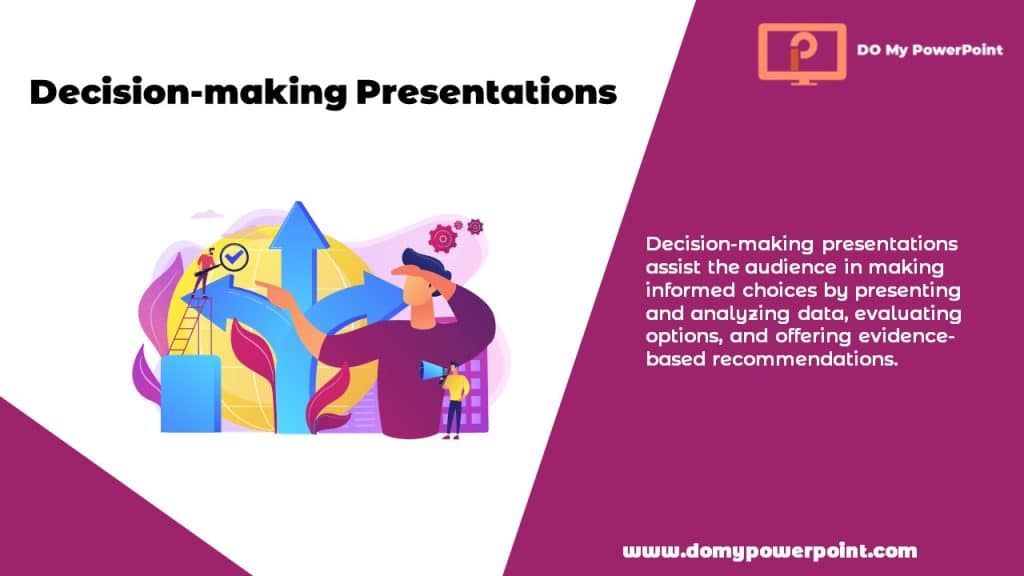
Decision-Making Presentations are a sort of presentation whose reason is to assist the gathering of people within the decision-making handle.
These sorts of presentations as a rule incorporate displaying data, analyzing information, assessing choices, and proposing conceivable arrangements so that the gathering of people can make way better choices based on the data displayed.
Decision-making presentations are frequently utilized in trade settings, venture administration, board gatherings, and indeed in individual and family decision-making.
In decision-making presentations, the speaker must carefully collect and analyze pertinent data and information and show them to the group of onlookers in an organized and justifiable way.
This incorporates utilizing charts, tables, infographics, and other visual devices to show information and examination. In expansion, the speaker ought to clearly clarify the stars and cons of each choice and give evidence-based proposals and point by point examination.
Cases of decision-making presentation incorporate advertise examination for presenting a modern item, assessing speculation choices for an expansive extend, looking at different procedures to progress organizational execution, and analyzing the dangers and benefits of different activities in an emergency circumstance.
For case, in a board assembly, a CFO might offer assistance the board choose whether to form a modern speculation by showing different budgetary information and examination. Or in an expansive extend, the venture director makes a difference the group to choose the leading arrangement by investigating and comparing distinctive extend usage choices.
In general, decision-making presentations play a critical part within the decision-making process by giving nitty gritty data and comprehensive investigation, making a difference the gathering of people to form choices more certainly. These sorts of presentations point to move forward the quality of choices by centering on clarifying data and assessing alternatives.
Key Characteristics and Best Practices
- Comparative analysis: Weighs advantages and disadvantages of many decisions.
- Logical flow: presents material in a methodical way.
- Data visualization helps decision-making by means of tables, graphs, and charts.
“Good decision-making depends on organized analysis and unambiguous facts.”
Examples of Scenarios
- meetings of business strategy
- financial planning and investments
- Talk about project management.
Visual Example/Template
- Slides for SWOT analyses
- trees for decision making
- Comparative tables
Status or Progress Report Presentation
The Status or Progress Report presentation is a vital category among the different types of presentations, offering updates on ongoing projects and overall performance.
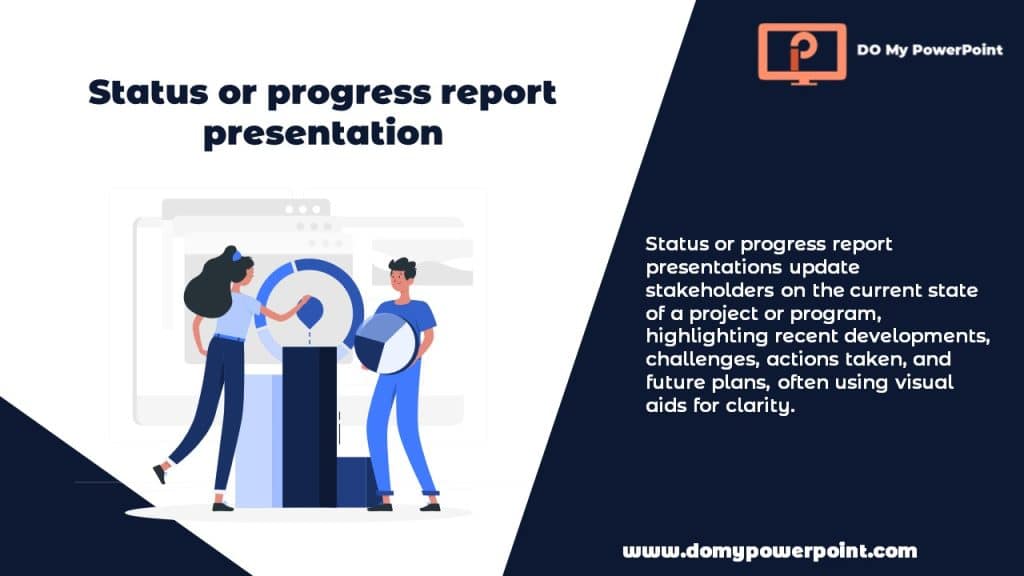
Status or Progress Report Presentation (Status or Advance Report Introduction) may be a type of presentation whose reason is to supply overhauls and data around the current status of a particular extend, program or movement to partners.
This type of presentation are usually held on a normal premise to guarantee that everybody included within the venture is up-to-date on the most recent status and advance. Status or progress report presentation can be utilized in an assortment of settings, counting trade, investigate ventures, advancement programs, and indeed group gatherings.
In status or progress report presentation, the speaker ought to display key data approximately the extend or program in a brief and valuable way. This data can incorporate later advancements, impediments and challenges, activities taken, and future plans.
Utilizing visual instruments such as charts, tables, and infographics can offer assistance to get it data superior and quicker. Moreover, straightforwardness and genuineness in giving data is exceptionally imperative so that partners can make the essential choices based on precise and solid information.
Chart of status or advance report introductions incorporate occasional reports on development ventures, upgrade gatherings on IT ventures, advance reports on inquire about ventures, and intermittent budgetary reports on companies.
For illustration, in a development extend, the venture director can offer assistance stakeholders stay informed almost the status of the extend by providing subtle elements almost the completion of different stages, issues experienced, and activities taken to resolve them.
Or in an IT extend, the extend chief can keep the group educated of advance by giving reports on the completion of different program modules, trials and tests, and specialized issues. in common, status or advance report introductions pointed at illuminating and upgrading partners almost the current status of a extend or program play an imperative part in extend administration and guaranteeing coordination and collaboration between group individuals and partners.
Finally, it should be said that this type of presentation is used to choose the right decision and prepare the prospects that are necessary for a business or program. Because it can simplify this topic by providing accurate data.
Key Characteristics and Best Practices
- Simple and Effective Structure: Information should be straight forward and to the point.
- Data-Driven — Show development via graphs, charts, and numerical data.
- Emphasize important insights; highlight only the most crucial points to prevent knowledge overload.
- Solution-Oriented Approach: Should problems arise, provide doable remedies.
- Audience Engagement: Motivational questions and comments for stakeholders.
Examples of Scenarios
- Monthly marketing team report on user growth measures;
- Construction project update for top management;
- Financial situation report for investors and shareholders.
Visual Example/Template
- Slide 1: report introduction (Project title, timeline, aim; );
- Slide 2: overall status summary;
- Slide 3: data presentation (important metrics, charts, tables);
- Slide 4: next steps and recommendations.
Visual-Heavy Presentations
With its emphasis on imagery and design, the Visual-Heavy presentation is one of the most engaging formats among the different types of presentations.
These presentations mostly depend on images instead of language to properly transmit the meaning.
Visual-heavy presentations engage the audience and rely on the strategic use of images, graphics, and multimedia components to appropriately communicate ideas. Unlike traditional text-heavy slides, these presentations use pictures that highlight challenging information top priority, generates emotional responses, and helps to clarify complex concepts.
Often utilized to break up content and make it more appealing for guests are infographics, graphs, charts, and fantastic images. Reducing word reliance allows visually compelling presentations to keep viewers concentrated and provide lifelong memories. These pictures also act as anchors for the story as they help speakers to precisely and clearly state their stance.
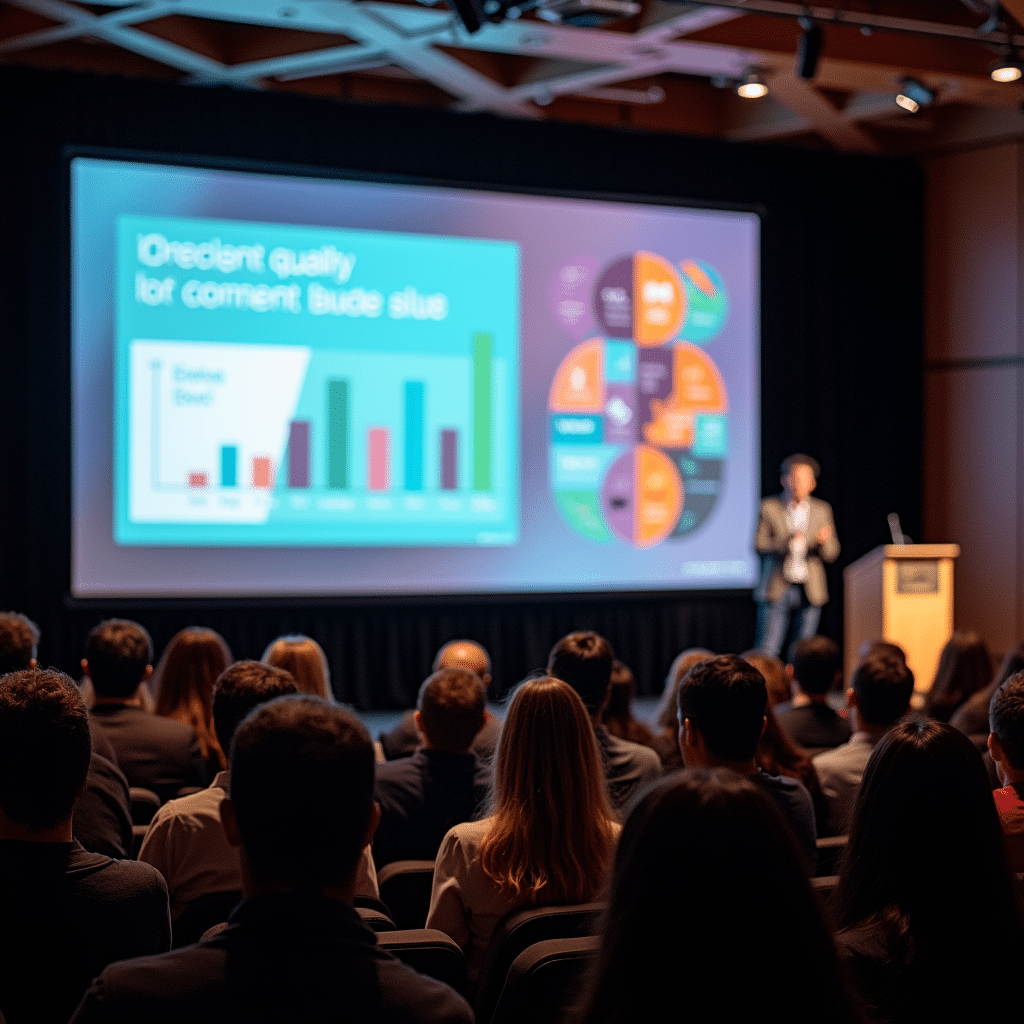
Make sure your visually demanding presentations have appropriate, high-quality photos suited for the subject of your presentation first. Infographics help to visually show a lot of facts and simplify difficult content so that it is more understood.
Choose harmonizing color schemes to guide the viewers in the right direction without dulling them. Even although multimedia elements—such movies or animations—should be utilized sparingly to avoid distractions—they nevertheless provide vitality.
Some presentations remain clear and focused by balancing fewer text with graphics. Always examine photos for clarity across multiple screen sizes as poor formatting or pixelation will impair the overall professionalism of the presentation.
Key Characteristics and Best Practices
- Minimal text: Emphasizes strong visuals.
- Excellent graphics: Employ expert images.
- Organized arrangement guarantees readability and clarity.
“In presentations especially, a picture is worth a thousand words.”
Examples of Scenarios
- portfolios of design and photography
- Presentations on travel and tourism
- Product exhibits and fashion trends
Visual Example/Template
- Whole-screen pictures
- Big symbols and little text on slide presentations
- Short, appealing titles
Interactive Presentations
The Interactive presentation stands out within the different types of presentations, actively involving the audience to create an engaging and participatory experience.
Interactive presentations are more interesting and successful for learning and teamwork as audience involvement is part of them.

Interactive presentations enthrall the audience, hence improving one-way communication. These presentations abound with real-time polls, tests, audience feedback, and Q&A.
It advance understanding, involvement, and in-depth conversations. Whether personal, corporate, or professional, their aim is to influence the audience from passive knowledge absorption to active engagement permanently. Live demonstrations, multimedia, and dynamic displays help to enhance interactive experience.
Good presentations combine gamification, interactive elements, comment areas high importance with real-time data sharing In this sense, I advise you to go over the article “Importance of Presentation Design“.. Content interaction rises with other multimedia technologies, augmented reality, and animation. Presenting reactive and adaptable allows audience adjustments and criticisms to be accepted.
Encourage a simple interface for technical tools and visuals to help to prevent technical issues and distractions. The purpose is to create a cooperative environment outside of traditional presentations encouraging knowledge, communication, and goal fulfillment.
Key Characteristics and Best Practices
- Live questions and answers sessions
- Clickable items and tests
- Interactive crowd comments in real time
“Engagement turns quiet observers into active participants.”
Examples of Scenarios
- Workshops for corporate training
- Webinars and online classes
- sessions of brainstorming and idea generation
Visual Example/Template
- Embedded quizzes
- Slide presentations for audience involvement
- Clickable navigation devices
How to Choose the Right Presentation Type
The audience, goal, and circumstance all influence the appropriate kind of presentation one chooses. This framework should assist you to decide on the ideal structure:
Table 2: Comprehensive guide to choosing the best type of presentation
|
Goal |
Best Presentation Type(s) |
Ideal Audience |
Best Setting |
| Educate or inform | Informative, Status/Progress Report | Employees, Stakeholders | Meetings, Conferences |
| Persuade or inspire action | Persuasive, Motivational | Customers, Investors, Employees | Sales Pitches, Leadership Talks |
| Demonstrate a process | Demonstration/How-To | Employees, General Public | Training, Workshops |
| Engage and interact | Interactive | General Public, Teams | Webinars, Live Events |
| Support decision-making | Decision-Making, Status Report | Executives, Project Teams | Board Meetings, Business Strategy |
| Captivate through storytelling | Storytelling | General Public, Employees | Keynote Speeches, TED Talks |
| Emphasize visuals over text | Visual-Heavy | Creative Teams, Large Audiences |
Marketing Pitches, Online Content |
FAQs About Different types of presentations
1. What is the best type of presentation for a business proposal?
Business proposals are best suited for a persuasive presentation as it emphasizes on persuading stakeholders or clients on the worth of your concept, product, or approach.
2. Can I combine multiple presentation types?
Definitely! Many good presentations combine many forms. A Motivational Presentation may include Storytelling, for instance, and an Interactive Presentation might also use Visual- Heavy components.
3. Which presentation type works best for remote or virtual settings?
Engaging virtual audiences best benefits from interactive presentations. Furthermore, webinars allow Visual-heavy and Demonstration Presentations to be very successful.
Conclusion of Different types of presentations
Learning many different types of presentations can help you to clearly express ideas in any environment. Whether your work is instructional, persuasive, inspiring, or informative, the correct structure improves your effect.
Key Learnings about different types of presentations:
- Before choosing a presenting style, state your aim.
- Think about your audience and the degree of involvement needed.
- When needed, use several techniques to get best results.
- Boost retention and impact by using interactivity and visual aids.
- Knowing these nine styles will help you create presentations your audience will find appealing and get the intended results.




